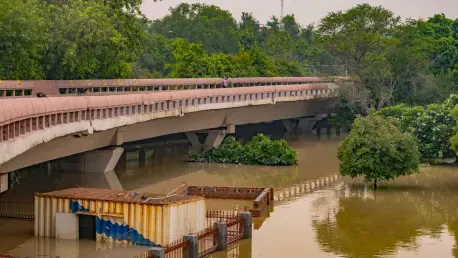In recent years, the increasing frequency and intensity of natural disasters have necessitated a reevaluation of infrastructure resilience, particularly in flood-prone areas. A remarkable example of this redefinition is the replacement of the Fitzroy River Bridge, which was a critical transport link on Australia’s Great Northern Highway. The original structure succumbed to devastating floods triggered by Cyclone Ellie in late 2022 and early 2023. This disaster highlighted the urgent need for robust infrastructure capable of withstanding extreme weather events. Through innovative engineering, strategic community engagement, and rapid project execution, the new Fitzroy River Bridge has set a benchmark in flood resilience, offering a blueprint for addressing future challenges posed by unpredictable weather patterns.
Fast-Track Success
Speedy Reconstruction Strategy
The replacement of the Fitzroy River Bridge was crucial, not only for restoring connectivity to remote communities but also for maintaining vital supply chains. The project was undertaken with unparalleled urgency and efficiency, completed six months ahead of schedule. Key to this rapid completion was adopting a streamlined design and construction process, which prioritized both speed and durability. This approach ensured that the bridge would be operational before the onset of the next wet season, thus averting further isolation of communities and potential economic disruptions.
The accelerated timeline also relied heavily on advanced engineering techniques and materials that could withstand future flood events. By integrating modern technological solutions and resilient construction practices, the team ensured that the redesigned bridge would provide a long-lasting solution rather than a temporary fix. Such proactive measures underscore the project’s emphasis on sustainable infrastructure development, addressing the current climate challenges with foresight and technical precision.
Community-Centric Approach
The success of the Fitzroy River Bridge project was significantly bolstered by its focus on community involvement and development. More than 240 local workers were employed throughout the project’s duration, offering them valuable employment opportunities and skills enhancement. This inclusive employment strategy was crucial in mitigating the socioeconomic impact of the bridge’s destruction, providing steady incomes and career development prospects for affected communities. Additionally, the engagement of 26 Aboriginal-owned businesses was a testament to the project’s commitment to inclusivity and empowerment.
Integrating local expertise and resources not only expedited project completion but also fostered a sense of ownership and pride among community members. Training programs offered during the construction phase equipped individuals with nationally recognized skills, contributing to long-term personal and professional growth beyond the project’s scope. This community-centric model aligns with the broader trend of infrastructure projects striving to have a meaningful and lasting positive impact on local populations.
Collaboration and Innovation
Strategic Partnerships
The collaborative approach adopted throughout the Fitzroy River Bridge replacement was instrumental in overcoming the challenges posed by such a complex engineering task. BG&E and Main Roads WA worked closely with contractors Georgiou and BMD, operating under an alliance model that emphasized coordination and open communication. This partnership extended to agencies such as the Bureau of Meteorology and the Department of Water and Environmental Regulation, enhancing the project’s ability to anticipate weather-related challenges and respond effectively.
By pooling interdisciplinary expertise, the project team was able to optimize decision-making processes and implement innovative solutions that balanced practicality with resilience. This strategic collaboration highlights a broader industry shift towards integrated approaches in project execution, recognizing that effective flood risk management requires the convergence of multiple disciplines and perspectives.
Enhancing Forecasting and Response
A notable aspect of the collaborative efforts was the enhancement of weather forecasting capabilities, which was critical for timely decision-making and risk mitigation. Working with meteorological experts allowed the project team to implement more accurate and reliable forecasting systems, ensuring that potential flood threats could be communicated swiftly and effectively. This partnership facilitated timely evacuation warnings and reinforced community safety protocols, which were crucial for protecting lives and property.
The project’s implementation of advanced forecasting techniques and collaborative response strategies sets a precedent for how critical infrastructure projects can better prepare for and adapt to environmental uncertainties. These proactive approaches not only reduce vulnerability to natural disasters but also build community trust and confidence in the infrastructure designed to protect them.
Building for the Future
Recognizing Excellence and Impact
The exemplary execution of the Fitzroy River Bridge replacement has not gone unnoticed, earning the prestigious 2025 FMA IAG Flood Risk Management Project of the Year Award. This accolade acknowledges the project’s innovative approach, speed of execution, and the profound impact it had on the surrounding communities. Alongside the recognition, BG&E and Main Roads WA received $10,000 towards further flood risk management or education endeavors, reaffirming the importance of continuous learning and improvement in disaster resilience practices.
Such accolades emphasize the vital role of infrastructure projects in safeguarding communities against the impacts of climate change. By setting a benchmark for future projects, the Fitzroy River Bridge serves as a compelling case study in how thoughtful planning and execution can deliver infrastructure that not only meets current needs but also anticipates future challenges.
Broader Implications
Replacing the Fitzroy River Bridge was essential, not only to reconnect isolated communities but also to keep crucial supply routes open. The project was executed with an extraordinary sense of urgency and efficiency, completing a remarkable six months ahead of schedule. This achievement was largely due to a streamlined design and construction process that focused on both speed and durability. This strategic approach ensured the bridge could be in operation before the next wet season, preventing further seclusion of communities and avoiding potential economic setbacks.
The rapid completion of this project also leveraged advanced engineering techniques and materials designed to endure future flooding. By incorporating modern technological solutions and resilient construction practices, the team’s efforts resulted in a long-term, sustainable infrastructure solution rather than a quick fix. These proactive efforts highlight the project’s commitment to sustainable development, addressing today’s climate challenges with careful planning and expert precision, ensuring that infrastructure remains reliable and effective for the future.









